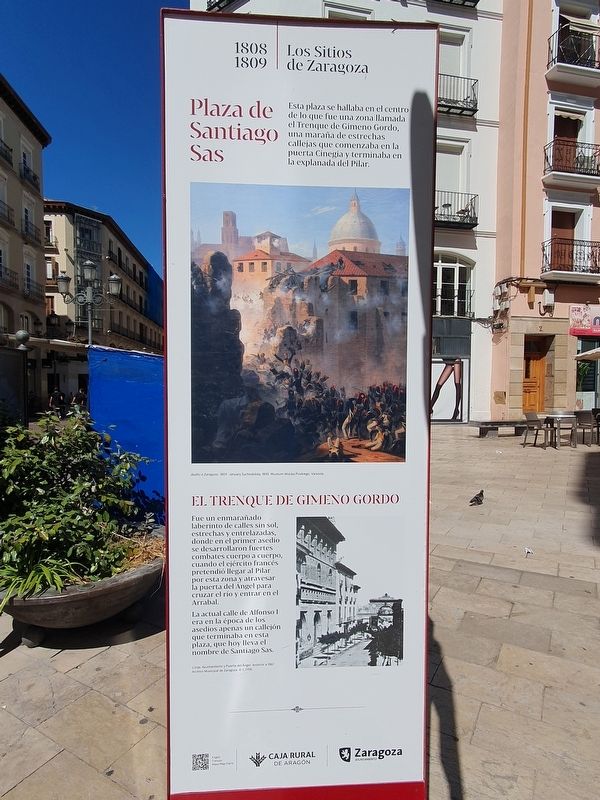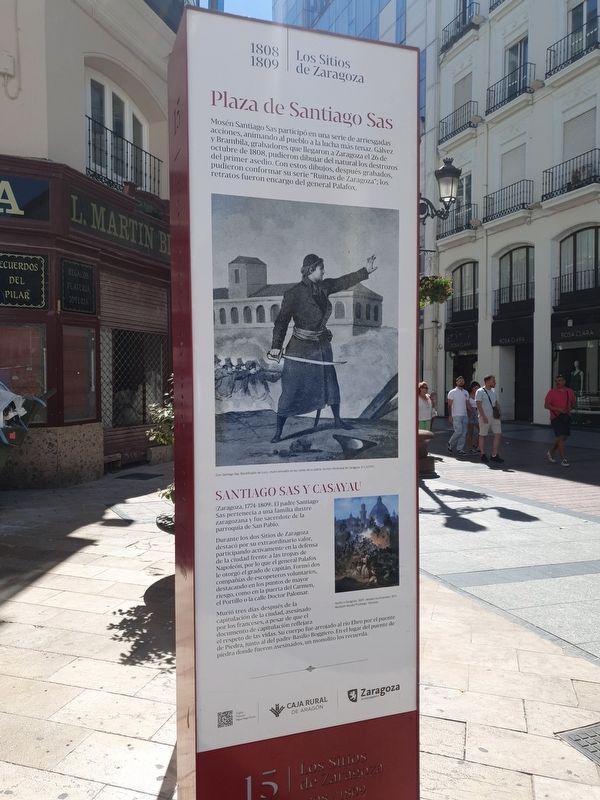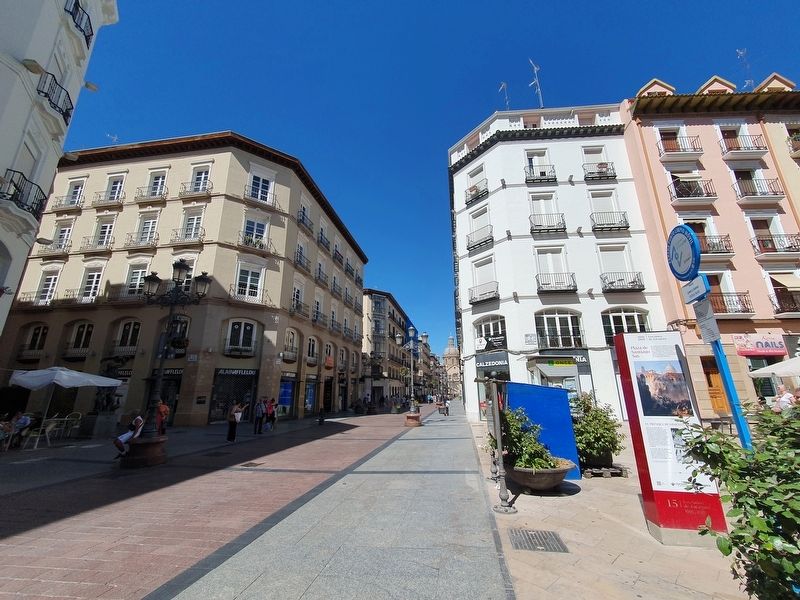Casco Antiguo in Zaragoza, Aragón, Spain — Southwestern Europe (Iberian Peninsula)
Plaza de Santiago Sas
1808 · 1809 Los Sitios de Zaragoza
Esta plaza se hallaba en el centro de lo que fue una zona llamada el Trenque de Gimeno Gordo, una maraña de estrechas callejas que comenzaba en la puerta Cinegia y terminaba en la explanada del Pilar
El Trenque de Gimeno Gordo
Fue un enmarañado laberinto de calles sin sol, estrechas y entrelazadas, donde en el primer asedio se desarrollaron fuertes combates cuerpo a cuerpo, cuando el ejército francés pretendió llegar al Pilar por esta zona y atravesar la puerta del Ángel para cruzar el río y entrar en el Arrabal. La actual calle de Alfonso I era en la época de los asedios apenas un callejón que terminaba en esta plaza, que hoy lleva el nombre de Santiago Sas.
Plaza de Santiago Sas
Mosén Santiago Sas participó en una serie de arriesgadas acciones, animando al pueblo a la lucha más tenaz. Gálvez y Brambila, grabadores que llegaron a Zaragoza el 26 de octubre de 1808, pudieron dibujar del natural los destrozos del primer asedio. Con estos dibujos, después grabados, pudieron conformar su serie “Ruinas de Zaragoza”; los retratos fueron encargo del general Palafox.
Santiago Sas y Casayau
(Zaragoza, 1774-1809). El padre Santiago Sas pertenecía a una familia ilustre zaragozana y fue sacerdote de la parroquia de San Pablo. Durante los dos Sitios de Zaragoza destacó por su extraordinario valor, participando activamente en la defensa de la ciudad frente a las tropas de Napoleón, por lo que el general Palafox le otorgó el grado de capitán. Formó dos compañías de escopeteros voluntarios, destacando en los puntos de mayor riesgo, como en la puerta del Carmen, el Portillo o la calle Doctor Palomar. Murió tres días después de la capitulación de la ciudad, asesinado por los franceses, a pesar de que el documento de capitulación reflejara el respeto de las vidas. Su cuerpo fue arrojado al río Ebro por el puente de Piedra, junto al del padre Basilio Boggiero. En el lugar del puente de piedra donde fueron asesinados, un monolito los recuerda.
Pie de dibujos
Asalto a Zaragoza, 1809. January Suchodolsky, 1845. Muzeum Wojska Poslkiego, Varsovia.
Lonja, Ayuntamiento y Puerta del Ángel. Anterior a 1867. Archivo Municipal de Zaragoza, 4-1_0196.
Don Santiago Sas. Beneficiado de Luco, murió envuelto en las ruinas de su patria. Archivo Municipal de Zaragoza, 4-1_02939.
Asalto a Zaragoza, 1809. January Suchodolsky, 1870. Muzeum Wojska Poslkiego, Varsovia.
Santiago Sas square
This square is located in the centre of a zone called Trenque de Gimeno Gordo, a maze of narrow alleys which started at the gate called Puerta Cinegia and ended at the El Pilar esplanade.
El Trenque de Gimeno Gordo
It was an intricate labyrinth of streets without sunlight, narrow and interconnected, where intense hand-to-hand combat took place, when the French army tried to reach the Pilar Cathedral through this zone and crossing the gate called Puerta del Ángel to cross the river and enter the Arrabal district.
At the time of the sieges, the current street: Calle de Alfonso I was hardly an alley which ended at this square, today, the street is named Santiago Sas.
Detail of an engraving from the 19th century which represents the first Siege of Zaragoza by the French.
Santiago Sas square
Father Santiago Sas participated in a series of high risk actions, encouraging the people to tenaciously fight to the maximum. Gálvez and Brambila, engravers who arrived in Zaragoza on 26 October 1808, were able to make eye witness drawings of the destruction from the first siege. With these drawings, subsequently engravings, they were able to create their series, “Ruinas de Zaragoza” (“Ruins of Zaragoza”); the portraits were commissioned by General Palafox.
Santiago Sas y Casayau
Father Santiago Sas (Zaragoza, 1774- 1809) belonged to an illustrious Zaragoza family and was a priest at the parish church of San Pablo.
During the Sieges of Zaragoza, he was noted for his extraordinary courage, actively participating in the defence of the city against Napoleon’s troops, for which General Palafox granted him the rank of Captain. At his expense, he organised two voluntary shotgunner companies from the parish of San Pablo, with whom he took part in the Battle of Las Eras. In the first siege, he was at all the major risk points, such as the Carmen and Portillo gates, at the Sancho gate or the street named Calle Doctor Palomar.
He was killed three days after the capitulation of the city, assassinated by the French, despite the fact that the capitulation document stipulated respect for lives. His body was thrown into the Ebro River from the stone bridge, together with Father Basilio Boggiero. At the site of the stone bridge where they were killed, a monolith now honours their memory.
Captions
Asalto a Zaragoza, 1809. January Suchodolsky, 1845. Muzeum Wojska Poslkiego, Varsovia.
Lonja, Ayuntamiento y Puerta del Ángel. Anterior a 1867. Archivo Municipal de Zaragoza, 4-1_0196.
Father Santiago Sas. Benefice priest of Luco, he died trapped inside the ruins of his country. Archivo Municipal de Zaragoza, 4-1_02939.
Asalto a Zaragoza, 1809. January Suchodolsky, 1870. Muzeum Wojska Poslkiego, Varsovia.
Topics. This historical marker is listed in this topic list: Wars, Non-US. A significant historical year for this entry is 1808.
Location. 41° 39.241′ N, 0° 52.865′ W. Marker is in Zaragoza, Aragón. It is in Casco Antiguo. Marker is at the intersection of Calle de Alfonso I and Plaza de Santiago Sas, on the right when traveling north on Calle de Alfonso I. Touch for map. Marker is in this post office area: Zaragoza, Aragón 50003, Spain. Touch for directions.
Other nearby markers. At least 8 other markers are within walking distance of this marker. Calle de Don Alfonso I (here, next to this marker); Santiago Ramón y Cajal (about 90 meters away, measured in a direct line); Pedro María Ric y Monserrat (about 210 meters away); Palacio de los Condes de Morata o de los Luna (about 210 meters away); Monument to the Martyrs to Religion and the Nation (about 210 meters away); Plaza de España (about 210 meters away); a different marker also named Plaza de España (about 240 meters away); José Sinués y Urbiola (about 240 meters away). Touch for a list and map of all markers in Zaragoza.
Also see . . . Plaza de Santiago Sas. The Ayuntamiento de Zaragoza maintains this website with Spanish, English and French versions of the markers in this series on the Sieges of Zaragoza in 1808 and 1809. (Submitted on October 16, 2023.)
Credits. This page was last revised on October 16, 2023. It was originally submitted on October 16, 2023, by J. Makali Bruton of Accra, Ghana. This page has been viewed 49 times since then and 13 times this year. Photos: 1, 2, 3. submitted on October 16, 2023, by J. Makali Bruton of Accra, Ghana.


